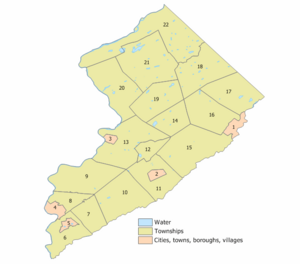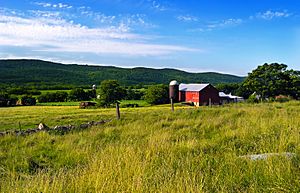Warren County, New Jersey facts for kids
Quick facts for kids
Warren County
|
|||
|---|---|---|---|
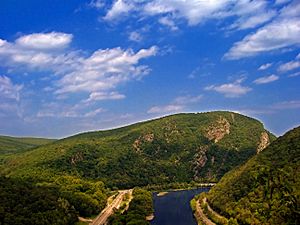
Delaware Water Gap (center) between Warren County (right) and neighboring Monroe County, Pennsylvania (left) in May 2008
|
|||
|
|||
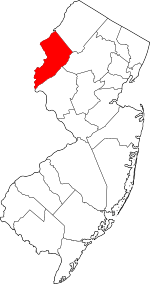
Location within the U.S. state of New Jersey
|
|||
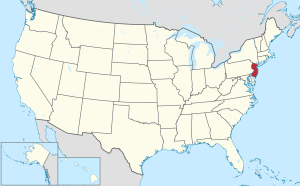 New Jersey's location within the U.S. |
|||
| Country | |||
| State | |||
| Founded | November 20, 1824 | ||
| Named for | Joseph Warren | ||
| Seat | Belvidere | ||
| Largest municipality | Phillipsburg (population) Hardwick Township (area) |
||
| Area | |||
| • Total | 362.65 sq mi (939.3 km2) | ||
| • Land | 356.54 sq mi (923.4 km2) | ||
| • Water | 6.11 sq mi (15.8 km2) 1.7% | ||
| Population
(2020)
|
|||
| • Total | 109,632 | ||
| • Estimate
(2023)
|
111,252 |
||
| • Density | 302.308/sq mi (116.7218/km2) | ||
| Time zone | UTC−5 (Eastern) | ||
| • Summer (DST) | UTC−4 (EDT) | ||
| Congressional district | 7th | ||
Warren County is a county located in the U.S. state of New Jersey. According to the 2020 census, the county was the state's 19th-most populous county, with a population of 109,632, its highest decennial count ever and an increase of 940 (+0.9%) from the 2010 census count of 108,692, which in turn reflected an increase of 6,255 (+6.1%) from 102,437 counted at the 2000 census. The county is part of the North Jersey region of the state.
The county borders the Delaware River and Easton, Pennsylvania in the Lehigh Valley to its west, the New York City metropolitan area to its east, the Poconos to its northwest, and Hunterdon County to its south.
Warren County constitutes part of the Allentown-Bethlehem-Easton, PA-NJ metropolitan statistical area in the Lehigh Valley and is the only New Jersey county not a part of the combined statistical areas of either New York City or Philadelphia. The county's most populous municipality is Phillipsburg, with 15,249 residents at the time of the 2020 census while Hardwick Township had both the largest area, 37.92 square miles (98.2 km2), and the fewest people with 1,696 residents. Its county seat is Belvidere.
Warren County was incorporated by an act of the New Jersey Legislature on November 20, 1824, from portions of Sussex County. At its establishment, the county consisted of the townships of Greenwich, Independence, Knowlton, Mansfield, Oxford, and the now defunct Pahaquarry.
Warren County is named for Joseph Warren, a patriot during the American Revolution and Founding Father of the United States who was killed in action by British troops at the Battle of Bunker Hill, in Charlestown, Massachusetts on June 17, 1775.
Contents
History
Etymology
The county was named for Joseph Warren, a physician, Founding Father of the United States, and major general in the American Revolutionary War who died after volunteering to fight as a private at the Battle of Bunker Hill.
Native Americans
About 1000 B.C., clay pottery was beginning to be used in the region, representing the beginning of the Woodland period. With this advancement in technology, Native Americans could store food and cook it better.
Various cultures of indigenous peoples occupied the area at that time. Ancestors of the Algonquian-speaking Lenape moved into the area, perhaps as early as 1000 A.D. from the Mississippi River area.
Technological innovations occurred around the year 500 A.D. with the invention of the bow and arrow as projectile points became smaller to fit onto an arrow shaft. This permitted Native Americans to procure more food since they could be further away from game to kill it. Food such as nuts could be stored in clay pots or the pots were used for cooking
Agriculture started around that time with the cultivation of corn, beans, and squash. Seeds were probably procured from traveling groups or tribes. Settlements of family groups became more stable, as they could store food in pottery, as well as procure more game with the bow and arrow. Agriculture contributed to the rise of population density in areas where crops could be grown. The Lenape would tend their oval gardens during the spring and summer months. They fished with nets or by hand in the shallow rivers. The Lenape trapped game with deadfalls and snares.
17th century
Problems developed in the early 17th century when the Little Ice Age began in North America. The late frost in May and June and early frosts in August or September, made the growing of crops difficult. Cold weather also made big and small game more difficult to hurt, as some game animals would hibernate. Also nut crops from oak, hickory, beech, walnut, butternut, and chestnut, failed at times; making the supply of these nuts scarce. Rivers froze early, and water became cold fast; so fishing became impossible. The Native populations had declined after epidemics of infectious diseases, for which they had no acquired immunity.
Native American populations were separated from Europe for thousands of years and had no immunity to these diseases that the Europeans brought with them. Many Native American populations were weakened from starvation due to the Little Ice Age, which was coldest during the 17th century. Their important corn, bean and squash crops failed due to spring frosts and early frosts in autumn. As the Native American population declined, more land was available for European settlement. All these factors made the Native American populations decline dramatically.
Europeans purchased land known as land patents so Native Americans moved west to Ohio or Canada. The Dutch settled the Hudson River Valley and claimed all lands west of the Hudson River in the early 17th century. In the Quintipartite Deed of 1674 to 1702, the Province of New Jersey was divided by two lines, the Keith Line and the Coxe-Barclay line, which created the border of eastern Sussex county from the headwaters of the Pequannock River. The western border was the Delaware River.
Later, after the lands were taken over by the British, colonial-era New Jersey was divided into two parts, East Jersey and West Jersey. In the 17th century, the area of present-day Warren County was part of Burlington County, which emerged as one of the Thirteen Colonies in British America prior to the mid-18th century American Revolution.
18th century
The area became Hunterdon County in 1714. In 1739, the area of Warren County was included in Morris County. In 1753, Sussex County, including present-day Warren County, separated from Morris County.
During the French and Indian War of 1754, fortified homes or small forts were built along the Delaware River from Phillipsburg to Port Jervis, New York. The mountains of Warren County were the frontier of the war. Hostilities between the British and the French began to spill over from the European continent into the colonies in the New World. After the Battle of Jumonville Glen in Fayette County, Pennsylvania on May 28, 1754, French colonists in North America armed several Native American tribes, who sided with the French.
During the French and Indian War, a part of the Seven Years' War in North America, Sussex County often was raided by bands of Native Americans, including Lenape, Shawnee, and Iroquois. In 1756, a small band of Lenape raided the homes of local militia commanders, killing several members of the Swartout family and kidnapping other settlers during the Hunt-Swartout raid. In response to these aggressions, Jonathan Belcher, the colonial-era governor of the Province of New Jersey authorized that eight forts to be constructed along the Delaware River to defend the New Jersey frontier from such incursions, and authorized the New Jersey Frontier Guard to man them. Several of these forts were little more than blockhouses, and others were personal homes that were fortified. The forts sprawled from present-day Phillipsburg through Belvidere. Blairstown, and along the eastern banks of the Delaware River to Port Jervis, New York.
19th century
By the early 1800s, settlements in Phillipsburg, Hackettstown, Belvidere, and Washington in Warren County emerged as cornerstone communities of Sussex County. In 1824, Warren County was established and Belvidere was named as its county seat.
Geography and climate
According to the U.S. Census Bureau, as of the 2020 census, the county had a total area of 362.65 square miles (939.3 km2), of which 356.54 square miles (923.4 km2) was land (98.3%) and 6.11 square miles (15.8 km2) was water (1.7%). Warren County has rolling hills with the Kittatinny Ridge in the west. Allamuchy Mountain and Jenny Jump Mountain are part of the New York – New Jersey Highlands, also known as the Reading Prong. Around 450 million years ago, a chain of volcanic islands collided with proto North America. The chain of islands went over the North American Plate, creating the Highlands from the island rock and establishing the Great Appalachian Valley. The final collision was when the African Plate collided with the North American plate. That was the final episode of the building of the Appalachian Mountains. Then the African plate tore away from North America.
The Wisconsin Glacier covered the northern part of the county from 21,000 to 13,000 BC. The glacier covered the top of Kittatinny Mountain and carved the terrain in the northern part of the county. The terminal moraine runs from north of Belvidere to the south of Great Meadows to north of Hackettstown, to the north of Budd Lake. Blairstown Township, Hope Township, half of Independence Township, part of White Township, and all of Allamuchy Township was covered by the Glacier. When the glacier melted, a lake was formed at Great Meadows. Slowly the lake drained leaving a large flat area filled with organic material.
The county is drained by three rivers. All three rivers are shallow and narrow. They are fresh water rivers that are excellent for fishing. The Paulins Kill drains the western portion of the county. The river flows from Newton to Blairstown Township, and then through Knowlton Township where it drains into the Delaware River. The Pequest River drains the middle of the county flowing from Andover Township through Allamuchy, then to Independence Township where it turns west and flows through White Township and then empties into the Delaware River at Belvidere. The third river is the Musconetcong. Starting at Lake Musconetcong, the river divides the county from Morris and Hunterdon. This river drains the southern portion of the county and empties into the Delaware River near Warren Glen.
Warren County is located in two valleys of the Great Appalachian Valley. The first is the Kittatinny Valley, which is in the northern part of the county, and the Lehigh Valley, which borders the southern part of the county.
The Lehigh Valley starts at the terminal moraine of the Wisconsin Glacier slightly north of Belvidere. It extends from the Delaware River south to where the Musconetcong River enters the Delaware River, northeast to the Jenny Jump Mountains and then along Route 80 to the Allamuchy Mountains to the terminal moraine near Hackettstown. The Kittatinny Valley is situated north of the terminal moraine; it runs north of Belvidere, to south of Great Meadows, then east to the north of Hackettstown. Towns such as Blairstown, Johnsonburg, Hope and Allamuchy are in the Kittatinny Valley
The highest elevation is 1,600 feet (490 m) above sea level on the Kittatinny Ridge, at two areas just south of Upper Yards Creek Reservoir, west of Blairstown. The lowest point is the confluence of the Delaware and Musconetcong rivers at the county's southern tip, at 160 feet (49 m) of elevation. The highest elevation on Allamuchy Mountain is 1,240 feet (380 m) on the ridge northeast of Allamuchy. On Jenny Jump Mountain the highest point is 1,134 feet (346 m) east of the Shiloh area or south of Interstate 80. Sunfish Pond has an elevation of 1,379 feet (420 m) and upper Yards Creek Reservoir is at 1,555 feet (474 m).
ZIP code locations
Climate and weather
Warren County has a humid continental climate (Dfa/Dfb). Average monthly temperatures in downtown Phillipsburg range from 29.0 °F (−1.7 °C) in January to 74.2 °F (23.4 °C) in July, while in Hackettstown they range from 27.0 °F (−2.8 °C) in January to 71.5 °F (21.9 °C) in July. The hardiness zones are 6a and 6b.
| Weather chart for Belvidere, New Jersey | |||||||||||||||||||||||||||||||||||||||||||||||
|---|---|---|---|---|---|---|---|---|---|---|---|---|---|---|---|---|---|---|---|---|---|---|---|---|---|---|---|---|---|---|---|---|---|---|---|---|---|---|---|---|---|---|---|---|---|---|---|
| J | F | M | A | M | J | J | A | S | O | N | D | ||||||||||||||||||||||||||||||||||||
|
3.1
37
19
|
2.8
41
21
|
3.6
50
28
|
4
61
37
|
4.1
72
47
|
4.3
80
57
|
4.7
85
62
|
3.9
83
60
|
4.3
76
52
|
4.5
65
41
|
3.6
54
32
|
3.6
42
24
|
||||||||||||||||||||||||||||||||||||
| temperatures in °F precipitation totals in inches source: The Weather Channel |
|||||||||||||||||||||||||||||||||||||||||||||||
|
Metric conversion
|
|||||||||||||||||||||||||||||||||||||||||||||||
Average temperatures in the county seat of Belvidere have ranged from a low of 19 °F (−7 °C) in January to a high of 85 °F (29 °C) in July, although a record low of −17 °F (−27 °C) was recorded in January 1994 and a record high of 101 °F (38 °C) was recorded in July 1999. Average monthly precipitation ranged from 2.77 inches (70 mm) in February to 4.65 inches (118 mm) in July.
Demographics
| Historical population | |||
|---|---|---|---|
| Census | Pop. | %± | |
| 1830 | 18,627 | — | |
| 1840 | 20,366 | 9.3% | |
| 1850 | 22,358 | 9.8% | |
| 1860 | 28,433 | 27.2% | |
| 1870 | 34,336 | 20.8% | |
| 1880 | 36,589 | 6.6% | |
| 1890 | 36,553 | −0.1% | |
| 1900 | 37,781 | 3.4% | |
| 1910 | 43,187 | 14.3% | |
| 1920 | 45,057 | 4.3% | |
| 1930 | 49,319 | 9.5% | |
| 1940 | 50,181 | 1.7% | |
| 1950 | 54,374 | 8.4% | |
| 1960 | 63,220 | 16.3% | |
| 1970 | 73,960 | 17.0% | |
| 1980 | 84,429 | 14.2% | |
| 1990 | 91,607 | 8.5% | |
| 2000 | 102,437 | 11.8% | |
| 2010 | 108,692 | 6.1% | |
| 2020 | 109,632 | 0.9% | |
| 2023 (est.) | 111,252 | 2.4% | |
| Historical sources: 1790–1990 1970–2010 2000 2010 2000–2010 2010-2020 |
|||
The county is part of the Allentown-Bethlehem-Easton, PA-NJ metropolitan statistical area in the Lehigh Valley.
2010 census
The 2010 United States census counted 108,692 people, 41,480 households, and 28,870 families in the county. The population density was 304.5 inhabitants per square mile (117.6/km2). There were 44,925 housing units at an average density of 125.9 per square mile (48.6/km2). The racial makeup was 90.29% (98,137) White, 3.51% (3,818) Black or African American, 0.14% (155) Native American, 2.46% (2,673) Asian, 0.03% (30) Pacific Islander, 1.81% (1,964) from other races, and 1.76% (1,915) from two or more races. Hispanic or Latino people of any race were 7.05% (7,659) of the population.
Of the 41,480 households, 31.2% had children under the age of 18; 55.1% were married couples living together; 10.2% had a female householder with no husband present and 30.4% were non-families. Of all households, 25% were made up of individuals and 10.1% had someone living alone who was 65 years of age or older. The average household size was 2.57 and the average family size was 3.1.
23.6% of the population were under the age of 18, 7.9% from 18 to 24, 24.1% from 25 to 44, 30.4% from 45 to 64, and 14.1% who were 65 years of age or older. The median age was 41.5 years. For every 100 females, the population had 94.6 males. For every 100 females ages 18 and older there were 91.5 males.
Economy
The Bureau of Economic Analysis calculated that the county's gross domestic product was $3.7 billion in 2021, which was ranked smallest of the state's 21 counties and was a 3.6% increase from the prior year.
Municipalities
The 22 municipalities in Warren County, with Census-designated places (CDPs) and other communities listed, are:
| Municipality (with map key) |
Map key | Mun. type |
Pop. | Housing units |
Total area |
Water area |
Land Area |
Pop. density |
Housing density |
School district | Communities |
|---|---|---|---|---|---|---|---|---|---|---|---|
| Allamuchy Township |
17 | township | 5,335 | 2,096 | 20.76 | 0.31 | 20.45 | 211.3 | 102.5 | Hackettstown (9–12) (S/R) Allamuchy (PK-8) |
Allamuchy CDP (156) Panther Valley CDP (4,391) |
| Alpha | 5 | borough | 2,328 | 1,032 | 1.70 | 0.03 | 1.67 | 1,417.2 | 617.4 | Phillipsburg (9–12) (S/R) Alpha (PK-8) |
|
| Belvidere | 3 | town | 2,520 | 1,140 | 1.49 | 0.04 | 1.45 | 1,847.0 | 785.4 | Belvidere | |
| Blairstown Township |
21 | township | 5,704 | 2,272 | 31.70 | 0.89 | 30.82 | 193.6 | 73.7 | North Warren (7–12) Blairstown (K-6) |
Blairstown CDP (493) Hainesburg CDP (part; 422) Paulina |
| Franklin Township |
10 | township | 2,968 | 1,219 | 24.13 | 0.09 | 24.04 | 132.1 | 50.7 | Warren Hills (7–12) Franklin Township (PK-6) |
Asbury CDP (270) Broadway CDP (213) New Village CDP (399) |
| Frelinghuysen Township |
18 | township | 2,199 | 826 | 23.57 | 0.24 | 23.32 | 95.6 | 35.4 | North Warren (7–12) Frelinghuysen (PK-6) |
Johnsonburg CDP (381) Marksboro CDP (186) |
| Greenwich Township |
7 | township | 5,473 | 1,870 | 10.54 | 0.01 | 10.53 | 542.5 | 177.6 | Phillipsburg (9–12) (S/R) Greenwich (PK-8) |
Greenwich CDP (2,558) Stewartsville CDP (636) Upper Stewartsville CDP (329) |
| Hackettstown | 1 | town | 10,248 | 3,755 | 3.71 | 0.10 | 3.61 | 2,696.1 | 1,041.1 | Hackettstown | |
| Hardwick Township |
22 | township | 1,598 | 619 | 37.92 | 1.32 | 36.60 | 46.3 | 16.9 | North Warren (7–12) Blairstown (K-6) |
|
| Harmony Township |
9 | township | 2,503 | 1,109 | 24.08 | 0.38 | 23.70 | 112.5 | 46.8 | Belvidere (9–12) (S/R) Harmony (PK-8) |
Brainards CDP (194) Harmony CDP (374) Hutchinson CDP (103) |
| Hope Township |
19 | township | 1,835 | 809 | 18.84 | 0.22 | 18.62 | 104.8 | 43.4 | Belvidere (9–12) (S/R) Hope Township (PK-8) |
Hope CDP (256) Mount Hermon CDP (172) Silver Lake CDP (368) |
| Independence Township |
16 | township | 5,469 | 2,325 | 19.89 | 0.15 | 19.74 | 286.8 | 117.8 | Hackettstown (9–12) (S/R) Great Meadows (K-8) |
Great Meadows CDP (305) Vienna CDP (881) |
| Knowlton Township |
20 | township | 2,894 | 1,212 | 25.33 | 0.58 | 24.75 | 123.4 | 49.0 | North Warren (7–12) Knowlton (PK-6) |
Columbia CDP (215) Delaware CDP (173) Hainesburg CDP (part; 422) Warrington |
| Liberty | 14 | township | 2,670 | 1,151 | 11.87 | 0.26 | 11.60 | 253.6 | 99.2 | Hackettstown (9–12) (S/R) Great Meadows (K-8) |
Mountain Lake CDP (494) Townsbury |
| Lopatcong | 8 | township | 8,776 | 3,420 | 7.16 | 0.06 | 7.10 | 1,129.0 | 481.8 | Phillipsburg (9–12) (S/R) Lopatcong (PK-8) |
Delaware Park CDP (739) Lopatcong Overlook CDP (692) |
| Mansfield Township |
15 | township | 7,781 | 3,316 | 29.93 | 0.11 | 29.82 | 259.1 | 111.2 | Warren Hills (7–12) Mansfield (PK-6) |
Anderson CDP (306) Beattystown CDP (4,701) Port Murray CDP (227) |
| Oxford Township |
12 | township | 2,444 | 1,033 | 5.89 | 0.10 | 5.79 | 434.5 | 178.5 | Warren Hills (9–12) (S/R) Oxford (K-8) |
Oxford CDP (1,033) |
| Phillipsburg | 4 | town | 15,249 | 6,607 | 3.31 | 0.12 | 3.19 | 4,682.1 | 2,069.2 | Phillipsburg | |
| Pohatcong | 6 | township | 3,241 | 1,420 | 13.71 | 0.36 | 13.36 | 250.0 | 106.3 | Phillipsburg (9–12) (S/R) Pohatcong (PK-8) |
Carpentersville Finesville CDP (364) Hughesville Upper Pohatcong CDP (1,714) |
| Washington Borough |
2 | borough | 7,299 | 2,897 | 1.95 | 0.00 | 1.94 | 3,326.8 | 1,491.7 | Warren Hills (7–12) Washington Borough (PK-6) |
|
| Washington Township |
11 | township | 6,492 | 2,493 | 17.75 | 0.09 | 17.66 | 376.6 | 141.1 | Warren Hills (7–12) Washington Township (PK-6) |
Brass Castle CDP (1,536) Changewater Port Colden CDP (260) |
| White | 13 | township | 4,606 | 2,304 | 27.63 | 0.48 | 27.15 | 179.8 | 84.9 | Belvidere (9–12) (S/R) White Township (PK-8) |
Bridgeville CDP (229) Brookfield CDP (727) Buttzville CDP (205) Foul Rift (ghost town) |
| Warren County | county | 109,632 | 44,925 | 362.86 | 5.94 | 356.92 | 304.5 | 125.9 |
Historical municipalities
- Pahaquarry Township (1854-1997)
Transportation

Roads and highways
As of 2010[update], the county had a total of 1,055.07 miles (1,697.97 km) of roadways, of which 690.53 miles (1,111.30 km) were maintained by the local municipality, 256.15 miles (412.23 km) by Warren County and 103.20 miles (166.08 km) by the New Jersey Department of Transportation and 5.19 miles (8.35 km) by the Delaware River Joint Toll Bridge Commission.
The county has a few notable state and federal roads. The chief state routes are Route 31, a north–south road that runs from Buttzville in White Township to Trenton, and Route 57 that runs between Lopatcong Township to Hackettstown. Route 94 in the northern part runs through Blairstown into New York state via Newton and the rest of Sussex County. Route 173 runs near Bloomsbury into Hunterdon County, terminating at Clinton and Annandale. Route 182 serves as one of the commercial areas of Hackettstown, & Route 122 serves as one of the commercial areas of Phillipsburg. The US Routes are U.S. Route 22 in the Phillipsburg area and U.S. Route 46 runs from Columbia to Hackettstown in the northern section. The two interstates that pass through are the Phillipsburg-Newark Expressway (Interstate 78), and the Bergen-Passaic Expressway (Interstate 80).
Air
By air, the county is served by Lehigh Valley International Airport in Allentown. Newark Liberty International Airport in Newark is located east of the county.
Bus
Warren County contracts with Easton Coach to provide demand-responsive service and limited fixed-route service along the Route 31 and Route 57 corridors. NJ Transit operates the No. 890 and No. 891 buses in the Phillipsburg area.
Rail
Warren County has a single NJ Transit train stop, located at the Hackettstown station on the Montclair-Boonton Line and the Morristown Line.
Norfolk Southern Railway's Lehigh Line, formerly the mainline of the Lehigh Valley Railroad, runs through southern Warren County on its way to Phillipsburg.
Education

Colleges
- Centenary University is a private college located in Hackettstown that is affiliated with the United Methodist Church.
- Warren County Community College, in Washington Township, offers both associate and bachelor's degree programs and certificate programs. The college serves approximately 1,700 full-time and part-time students, in addition to students in non-credit programs and courses. The college is able to offer bachelor programs through partnerships with four-year colleges.
Private secondary schools
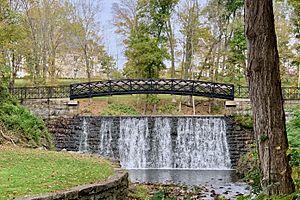
- Blair Academy is a college preparatory school located in Blairstown, founded in 1848 with a gift from John Insley Blair.
School districts
School districts in Warren County include:
- K-12 districts
- Belvidere School District
- Hackettstown School District
- Phillipsburg School District
- Warren County Special Services School District
- Secondary districts
- North Warren Regional High School 7–12
- Warren County Vocational School District 9–12
- Warren Hills Regional School District 7–12
- Elementary districts
- Alpha School District K–8
- Allamuchy Township School District K–8
- Blairstown Township School District K–6
- Franklin Township School District (Warren County, New Jersey) K–6
- Frelinghuysen Township School District K–6
- Great Meadows Regional School District K–8
- Greenwich Township School District K–8
- Harmony Township School District K–8
- Hope Township School District K–8
- Knowlton Township School District K–6
- Lopatcong Township School District K–8
- Mansfield Township School District K–6
- Oxford Township School District K–8
- Pohatcong Township School District K–8
- Washington Borough Public Schools K–6
- Washington Township School District K–6
- White Township School District K–8
Public high schools
- Belvidere High School, a part of the Belvidere School District (PreK-12) with students attending from Harmony, Hope and White townships
- Hackettstown High School, a part of the Hackettstown School District (PreK-12) with students from Allamuchy, Independence, and Liberty townships
- North Warren Regional High School, which serves the northern townships of Blairstown (where the school is located), Frelinghuysen, Hardwick and Knowlton
- Phillipsburg High School, a part of the Phillipsburg School District (PreK-12) with students attending from Alpha Borough and the Townships of Greenwich, Lopatcong and Pohatcong.
- Warren County Technical School serves the entire county. It includes grades 9–12 and also has a post secondary night school.
- Warren Hills Regional High School, a part of the Warren Hills Regional School District that serves the Borough of Washington, and the Townships of Washington, Mansfield, Franklin and Oxford (9–12 only)
Parks and Recreation
Most of Warren County is part of the Warren Hills Viticultural Area, and the county has five active wineries:
Warren County borders the Delaware Water Gap National Recreation Area and the Middle Delaware National Scenic River. Warren County has many areas for hunting and fishing. The New Jersey Division of Fish and Wildlife houses its Pequest Fish Hatchery, which produces trout and other fish, in Warren County about five miles northeast of Oxford, along U.S. Route 46. Thousands of trout are raised in this hatchery and also serves as an educational center for other outdoor activity. Wildlife Management Areas in the county include White Lake, Oxford Lake, and the Pequest River W.M.A. The five major rivers or creeks for fishing in Warren County are the Paulinskill, the Pequest, the Musconetcong, Pohatcong Creek, as well as the Delaware River. Merrill Creek Reservoir, located in Harmony Township, is also stocked with fish and has game in the surrounding woods.
See also
 In Spanish: Condado de Warren (Nueva Jersey) para niños
In Spanish: Condado de Warren (Nueva Jersey) para niños




